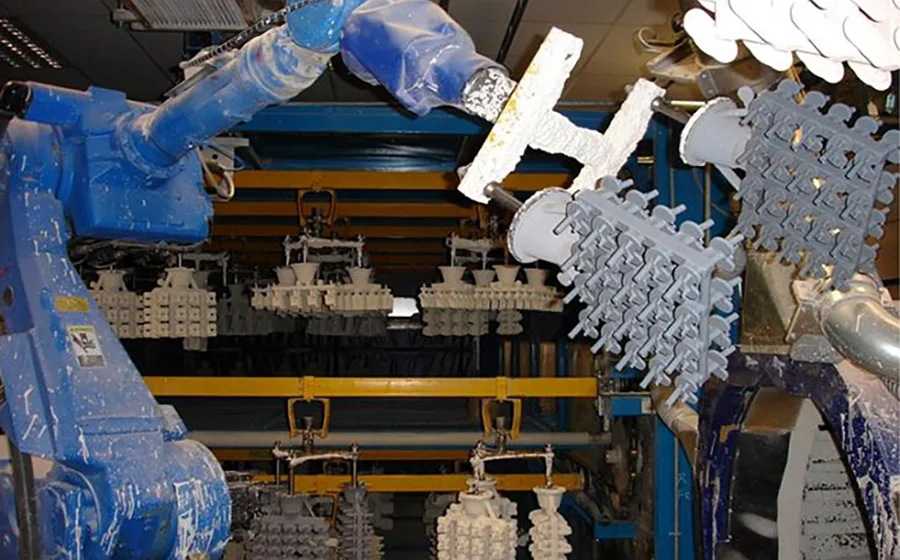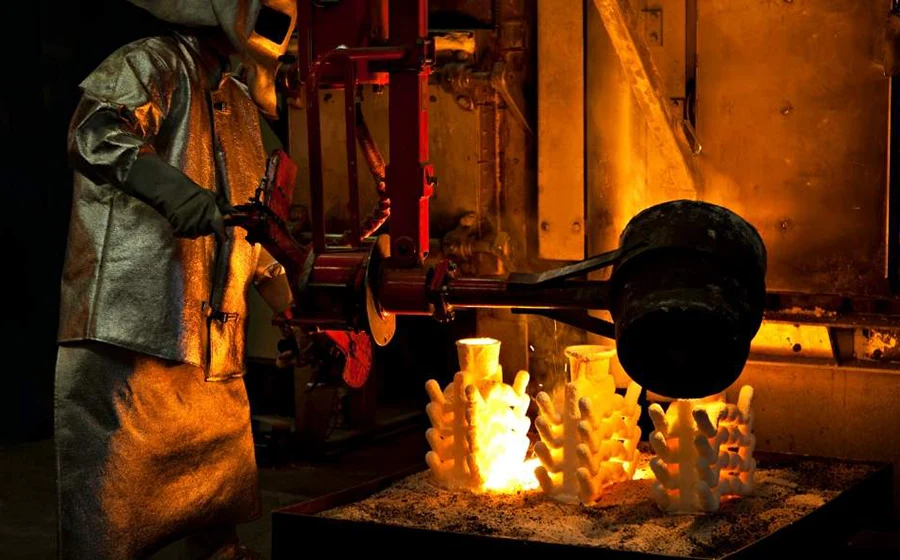Investment casting is a technique used to produce very precise and intricately shaped metal pieces. The choice of mold material is critical to the final product’s quality. Two common materials used are water glass and silica sol, each offering distinct advantages based on factors like surface finish, dimensional accuracy, and the type of metal being cast.
This article compares both casting methods, highlighting their differences, benefits, limitations, and suitable applications, with a summary table to help manufacturers choose the best option for their needs.
Introduction to Investment Casting
Investment casting, also known as the lost-wax process, involves creating a mold from a pattern (often made from wax), which is then coated with a refractory material to form a shell. Once the shell solidifies, the desired portion is formed by pouring molten metal into the mold hole and melting away the pattern.
A major factor in deciding the ultimate quality of the cast is the casting shell, also known as the mold. The choice of mold material influences factors such as casting accuracy, surface finish, and mold strength. Among the various mold materials, water glass and silica sol are two popular options, each with unique properties.
Water Glass Investment Casting

Water glass (also known as sodium silicate) is an inorganic compound that has been used for investment casting for many years. It is an adaptable substance that works well for many different casting applications.
Key Characteristics of Water Glass Investment Casting:
- Composition: Water glass is typically composed of sodium silicate and silica sand. The mixture is combined to form a slurry, which is then applied to the pattern to form the mold.
- Mold Strength: Water glass molds have a reputation for being extremely strong and resistant to high temperatures.
- Casting Surface: The surface finish of water glass castings is generally good but may require additional finishing processes to meet certain standards.
- Applications: Metals like bronze, brass, and aluminum that have lower melting points are frequently cast using water glass. It is also used in applications where mold strength and heat resistance are crucial.
Advantages of Water Glass Investment Casting:
- Cost-Effective: Water glass molds are less expensive compared to silica sol molds, making it a popular choice for large-scale production.
- Good Mold Strength: Water glass provides high mold strength and excellent heat resistance, which is ideal for casting metals with lower melting points.
- Suitable for Large Parts: Water glass casting can handle larger parts without compromising mold integrity.
Limitations of Water Glass Investment Casting:
- Lower Surface Finish: While the surface finish is generally good, it may not meet the stringent requirements for certain high-precision applications.
- Limited Precision: Water glass casting may not be suitable for extremely intricate designs or parts with tight tolerances.
Silica Sol Investment Casting

Silica sol (also known as colloidal silica) is a more advanced material used for investment casting, offering higher precision and a smoother surface finish than water glass.
Key Characteristics of Silica Sol Investment Casting:
- Composition: Silica sol is made from silica nanoparticles suspended in water. The pattern is usually coated with a slurry made from it and fine silica sand.
- Mold Strength: Silica sol molds are extremely strong and can withstand high temperatures. They are especially useful for casting high-melting-point metals such as stainless steel, superalloys, and titanium.
- Casting Surface: Silica sol molds produce castings with an excellent surface finish and finer details compared to water glass molds.
Applications: High precision applications like medical, automotive, and aerospace components are best suited for silica sol investment casting.
Advantages of Silica Sol Investment Casting:
- Superior Surface Finish: Silica sol reduces the need for labor-intensive post-casting finishing procedures by offering a far finer surface finish.
- High Precision: Silica sol casting is perfect for complex and detailed items because it provides exceptional dimensional accuracy.
- Excellent for High-Melting Metals: Silica sol is particularly suited for casting high-melting-point metals like stainless steel, titanium, and superalloys.
Limitations of Silica Sol Investment Casting:
- Greater Cost: Because of the higher cost of materials and the more involved mold-making process, silica sol investment casting is often more expensive.
- Limited Size Range: Silica sol molds are more suited to smaller, high-precision parts rather than larger castings.
A Comparison Between Water Glass and Silica Sol Investment Casting
Based on important criteria, the following table compares water glass and silica sol investment casting side by side:
| Property | Water Glass Investment Casting | Silica Sol Investment Casting |
| Mold Material | Sodium silicate and silica sand | Colloidal silica and fine silica sand |
| Casting Precision | Moderate | High |
| Surface Finish | Good, may require finishing | Excellent, minimal finishing needed |
| Cost | Lower cost | Higher cost |
| Temperature Resistance | Good for lower melting point metals | Excellent for high-melting metals |
| Part Size | Suitable for larger parts | Suited for smaller, intricate parts |
| Common Applications | Aluminum, brass, bronze | Stainless steel, titanium, superalloys |
| Strength | High mold strength | Very high mold strength |
| Tolerances | Moderate | Tight tolerances |
Choosing the Right Casting Method for Your Needs
When to Choose Water Glass Investment Casting:
- Cost-Effective: If you’re working on a budget or producing a large number of parts with less intricate designs, water glass investment casting can provide a cost-effective solution.
- Lower Melting Point Metals: Water glass is ideal for casting metals like aluminum, brass, and bronze, which do not require the extreme heat resistance of silica sol.
- Larger Parts: If your application involves larger parts, water glass investment casting provides the necessary strength and durability without the limitations on part size.
When to Choose Silica Sol Investment Casting:
- High Precision and Fine Details: For applications requiring tight tolerances, high precision, and fine details, such as those in aerospace or medicine, silica sol is the ideal option.
- High-Melting-Point Metals: Silica sol is preferred for casting metals with higher melting points, like stainless steel, titanium, and superalloys.
- Superior Surface Finish: If a smooth, high-quality surface finish is critical, silica sol investment casting is the better option.
Applications of Water Glass and Silica Sol in Investment Casting
Water Glass Investment Casting Applications:
- Automotive Parts: Water glass is commonly used for casting automotive components such as engine blocks, brackets, and housings made from aluminum and other non-ferrous metals.
- Industrial Machinery: Large industrial parts like pumps, valves, and gears are often cast using water glass.
- General Manufacturing: Water glass casting is widely used in the production of general engineering parts that do not require extreme precision.
Silica Sol Investment Casting Applications:
- Aerospace: Silica sol casting is used for producing turbine blades, nozzle guide vanes, and other critical components in jet engines made from high-performance alloys.
- Medical Devices: Silica sol is ideal for casting intricate medical implants and surgical instruments, where precision and surface finish are paramount.
- Automotive Performance Parts: High-performance engine components, including exhaust manifolds and valve bodies, are often cast using silica sol for its superior surface quality and precision.
